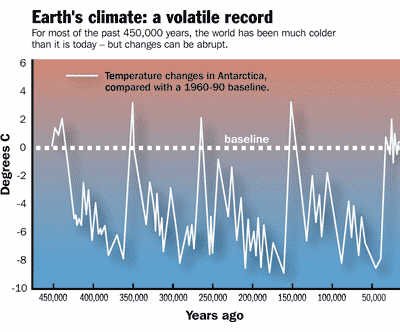RE: Antarctica is losing a lot of mass from it's thinning glaciers, but does that mean it's losing more than its gaining?
The Time Span is the Key
More than anything else, time is the key factor in understanding global warming. The earth doesn’t run on human time frames – like most planets it runs on much longer cycles. If we look at the past 2000 years, it’s true that the temperature is at the upper end of it’s range right now. But 2000 years is insignificant to a planet – the sort of time span we need to be looking at is half a million years
The patterns of warming and cooling become clearer the longer the time span we look at – in fact over 500,000 years the temperature chart looks almost like a heartbeat. Yes, it’s been hotter, and it’s been colder, and it’s managed to do both without any help from humans…
Over this time frame the key factor in temperature change appears to be variations in the shape of earth’s elliptical orbit – when we orbit closer to the sun the earth gets hotter.
Approximately every 100,000 years Earth’s climate warms up temporarily. These warm periods, called interglacial periods, appear to last approximately 15,000 to 20,000 years before regressing back to a cold ice age climate. At year 18,000 and counting our current interglacial vacation from the Ice Age is much nearer its end than its beginning.
http://www.frot.co.nz/design/sift/global-warming/
